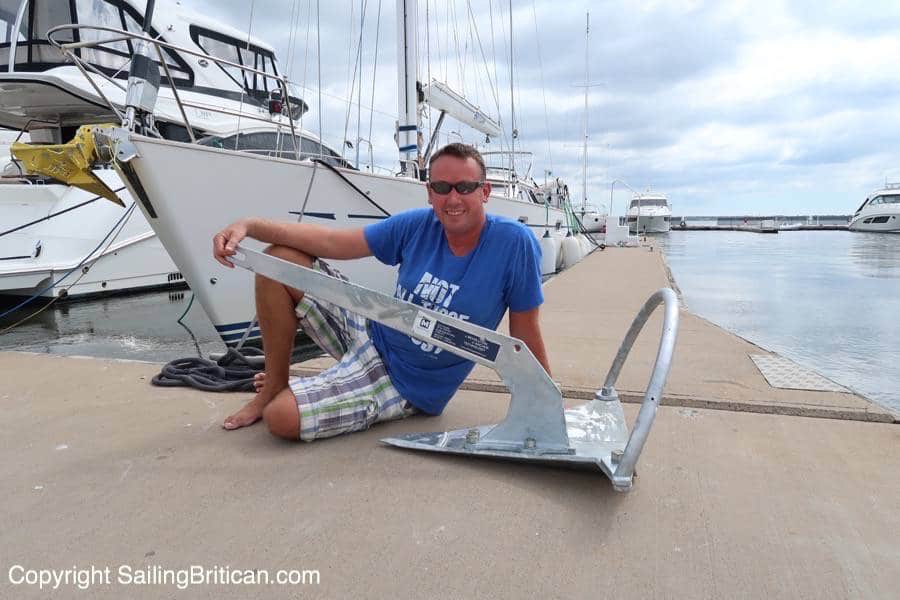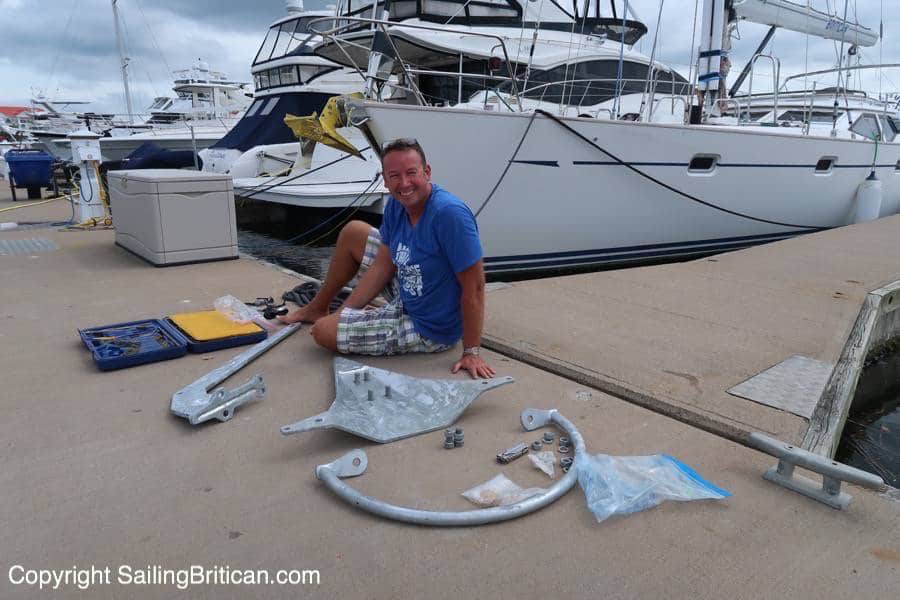If you ask ten sailors the best anchor for boat, you’ll get ten different answers. Furthermore, what works for one sailboat or sailor won’t necessarily work for you. To get the best answer, first answer the following questions:
- Type of boat?
- Weight of boat?
- Beam (width)?
- Where will you predominantly be anchoring?
- What depths will you be anchoring in? What is the depth of water at high tide?
- What is the seabed predominantly – mud, sand, grass, rocks?
- Do you have a preference for the types of anchors used by sailboats?
- The season you’ll be sailing in – outside of hurricane/typhoon season?
- Do you have a preference on how much chain or rope you want to carry?
- How will you pull the anchor up – your hands, automatic winch, etc.?
The Right Anchor for My Boat?
Once you have some or all of those details, you can seek out other sailors with similar specifications. Ask them what they’ve used in the past and if they can tell you what hasn’t worked and what has worked best.
You can also take your information and compare and contrast the types of sailboat anchors that work best under the conditions you’ve laid out. Sailboat anchoring types range from those that are good in mud to those that are better for sand. Some yacht anchors will fit your boat, and others won’t. The best sailboat anchors for one type of boat won’t be the best for others. It’s essential to do your research on the best anchor for boat. Always consider the pros cons and cons pros!
There are Two Major Components the Best Anchor for Boat
Success is not all about the anchor. It’s also about the anchoring technique used.
Out of all the things I see that sailors get wrong (inexperienced and experienced), anchoring is top of the list. I include myself – how do you think I’ve learned how not to drag?
A fantastic anchor, perhaps perfect for your boat, won’t do you any good if you don’t correctly set the anchor (backing down on it) using the correct amount of scope, considering the seabed, weather conditions, etc.
If you’re new to anchoring and mooring balls, make sure to get a copy of our Checklists for Sailors. It includes a step-by-step checklist on both that will drastically reduce your chances of dragging.
Let’s focus on the question at hand: what is the best anchor for boat?
It would be best if you matched the strength of your anchoring equipment to your boat and its likely cruising grounds/conditions. In other words, you’ll need to determine what the load, or pressure, on the ground tackle, will be in your worst-case scenario. Will you be sailing on a lake experiencing a maximum of 30 knots of wind, OR might you get caught in a tropical storm or hurricane?
Once you understand the worst conditions you might get caught in, you’ll be best apt to decide what anchoring equipment is required to keep your boat from dragging.
Of course, if you’re only sailing in an area with one kind of sea bottom, research the various anchors to determine which one excels in that kind of setting. Better yet, ask locals as to the best anchor for boat in the area.
However, if you’ll be cruising to various locations, it’s important to get the best all-around anchor.
When we started looking for the best anchor for boat, aside from being adequate to handle our load, we looked for the following:
- Needs to set fast
- Easy to drop/launch and fits well with the windless and on the anchor plate
- Sets in a variety of different bottoms (predominantly sand and mud)
- It is likely to reset itself if it does break loose
- Low risk of being fouled by the anchor chain when the boat swings
- It can break down, making it easy for stowage
- It is light enough to be able to pick up but heavy enough to drop quickly and dig in
- Will hold firm during storms – best anchor for boat!
We watched several YouTube video reviews, many Mantus anchor reviews, asked what other sailors were buying, and read various compare and contrast articles.
With a variety of good options out there, we felt somewhat confused as to the best way forward…
That is, until we discovered a Mantus dinghy anchor.
Our grapnel anchor was terrible and we needed something better to hold our dinghy. If you’ve ever been to the Caribbean, there are dinghy docks on most islands. The docks are great, but if you fail to use an anchor to keep the dinghy from smashing into the dock with the tide you’ll soon have a popped dinghy.
Yes – we learned that by experience too.
We popped our old dinghy on a dock nail in Mustique
Very rarely did we ever anchor our dingy for the sole purpose of anchoring – it was almost always used as a popping prevention tool. It’s a bit different from an anchoring sailboat.
Simon would tie us onto the dinghy dock, throw the anchor over, jump off the boat into the water to push the anchor in (grapnels are terrible for setting themselves), and then he’d get back in the boat, pull the anchor line tight, and off we went.
Hardly an ideal process. And Simon had to walk around wet for a while!
After watching a Mantus anchor review, we acquired one. Upon getting the new anchor, Simon, Sienna and I decided to test its effectiveness against the Bruce (claw) and grapnel. We tested all three anchors in dry sand (to see how they moved), wet sand to see if they set, and out in the harbor to put them under an engine load. Watch our Dinghy Anchor Review video here.
Hands down, the Mantus anchor was the winner.
With such positive results, we decided to watch a Mantus M2 Anchor Review.
It wasn’t difficult to determine that the M2 suited our needs.
The Mantus M2 Anchor ticked all our needs:
- It’s one of the fastest-setting anchors out there
- It’s easy to drop off our bow and fits our anchor plate area
- The Mantus M2 anchor sets in sea bottoms that we mostly anchor in – sand and mud
- If the Mantus gets turned upside down (something that worried us with our previous anchor) the roll bar enables the anchor to right itself and reset
- If we need to store the Mantus anchor, it breaks down and lays flat
- I can lift it up. Our previous anchor, the Excel, was impossible for me to lift.
I’ve written this article not necessarily to promote Mantus, but to show you the process in which we came to our anchoring sailboat conclusion. There are loads of great anchors out there, but the key is to find the one that will be best for you.
If you do, however, want a Mantus, we’re a part of their affiliate program. If you click this link and then buy anything on the Mantus website you don’t pay any more yet we get a commission. Using affiliate links helps to pay for articles like these and the 100+ videos that we have on YouTube. Click here to check out Mantus Anchors
When you do get a Mantus Anchor, make sure to use the Mantus anchor sizing chart, or better yet call them – they are extremely helpfully. Below is a video about how it comes packaged and how you’ll need to put it together.
Mantus Anchor – How to assemble it
Any comments or questions on anchor sailboat or anchor and sail? Leave them below.
Links to Items mentioned in the video:
- Buy the t-shirt Simon is wearing in the video! It displays a Britican exclusive compass design with the quote, ‘Not all those who wander are lost’ by Tolkien Buy now!
- Check out an anchor, or other goodies, at Mantus Anchors – clicking on this link will enable us to get a commission from your purchase at no extra cost to you. Affiliate, t-shirt and guide sales are a large portion of the funds that help to pay for hosting, IT support, video equipment, etc. thus providing quality free educational information.
- Watch our Dinghy Anchor Review here.
And if you want more information on anchoring, check out the following:
- Preventing Anchor Drag – Lessons Learned while using two anchors during a hurricane threat.
- New Anchor Chain Checklist
- Using An Anchor Alarm App
- Advanced Anchoring Techniques
- 8 Steps To Anchoring In A Storm


This is awesome information! We have a Bruce, which is perfect for sailing in the PNW where most bottoms are fairly muddy. We have only owned (and lived aboard) for almost a year, so we are still fairly new at anchoring, but we spent two weeks in the San Juans at anchor and we learned a lot! You’re right about it not all being about the type of anchor. We found that a huge part of our success was how well we communicated with each other while anchoring. It helps so much when you can work as a team!
So true about working as a team. I fear that many marriages have been ended due to anchoring debates. Hehehehe. I just don’t think new sailors (and even some seasoned sailors) understand the art of anchoring. It’s not as easy as it looks. Thanks for commenting Steph. K.
10.09.2017
Hi all
Excellent anchor post.
Those 7# grapnel anchor are alright for a drag anchor on 10-16-ft. fishing tender however to give more dig in attach 7 to 10 ft. heavy chain leader w/heavy shackle & 5 -10 # kellet at crown eye & large swivel shackle at other end of chain leader – tie a light wt. zip tie to anchor shank eye & a chain link – then will be able to trip anchor should it become fouled.
Great info re the Mantus anchor. I’m going to buy M2 model now.
I used this anchor SeaChoice 41610 on my 14ft Jon boat. First off it’s the weight. This is so light I couldn’t believe it. The second was the hold. Once I figure out how it works you won’t move. I had this in 12-16mph winds, and my boat never moved from its spot.